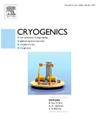Construction of a precise measuring probe based on tunnel diode oscillator
IF 1.8
3区 工程技术
Q3 PHYSICS, APPLIED
引用次数: 0
Abstract
Metrology utilizing resonance techniques is a cornerstone for precise measurement of small signals. Resonances in mechanical oscillation, electric circuit, electromagnetic circuit, and optical cavity have been proven as powerful tools across a wide spectral range. In this study, we present the construction and characterization of a tunnel diode oscillator (TDO) circuit optimized for operating at cryogenic temperatures down to . By taking advantage of the negative differential resistance (NDR) of a tunneling diode (TD), the TDO circuit is able to sustain a continuous oscillation. A quality factor of is achieved by careful optimization of the circuit's operating point, thus realizing sensitive detection of variations in inductance and capacitance. The TDO circuit is integrated to a cryostat insert and converted as a measuring probe for magnetic properties. We tested the probe by characterizing the superconducting transition of niobium. The evolution of magnetic penetration depth (λ) was measured with an uncertainty of around 0.2% across the transition in various magnetic field. Our results demonstrate the significant potential of TDO technique for cryogenic studies in physical sciences.
基于隧道二极管振荡器的精密测量探头的研制
利用共振技术的计量是精确测量小信号的基石。机械振荡、电路、电磁电路和光学腔中的共振已被证明是广泛光谱范围内的有力工具。在这项研究中,我们提出了一个隧道二极管振荡器(TDO)电路的结构和特性,该电路优化后可在低至1.5K的低温下工作。利用隧道二极管(TD)的负差分电阻(NDR), TDO电路能够维持连续振荡。通过对电路工作点的精心优化,达到了Q≈3.5×105的品质因数,从而实现了对电感和电容变化的灵敏检测。TDO电路集成到低温恒温器插入和转换为测量探头的磁性。我们通过表征铌的超导转变来测试探针。磁穿透深度(λ)在不同磁场下的不确定度约为0.2%。我们的研究结果证明了TDO技术在物理科学低温研究中的巨大潜力。
本文章由计算机程序翻译,如有差异,请以英文原文为准。
求助全文
约1分钟内获得全文
求助全文
来源期刊

Cryogenics
物理-热力学
CiteScore
3.80
自引率
9.50%
发文量
0
审稿时长
2.1 months
期刊介绍:
Cryogenics is the world''s leading journal focusing on all aspects of cryoengineering and cryogenics. Papers published in Cryogenics cover a wide variety of subjects in low temperature engineering and research. Among the areas covered are:
- Applications of superconductivity: magnets, electronics, devices
- Superconductors and their properties
- Properties of materials: metals, alloys, composites, polymers, insulations
- New applications of cryogenic technology to processes, devices, machinery
- Refrigeration and liquefaction technology
- Thermodynamics
- Fluid properties and fluid mechanics
- Heat transfer
- Thermometry and measurement science
- Cryogenics in medicine
- Cryoelectronics
 求助内容:
求助内容: 应助结果提醒方式:
应助结果提醒方式:


